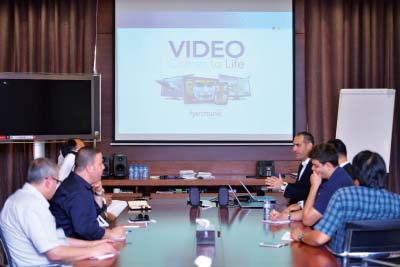Dubai Media Incorporated (DMI) hosted a technology week this May, showcasing the latest technological offerings from broadcast vendors. Featuring presentations and product demos, the event brought together leading vendors from various parts of the broadcast chain at DMI headquarters in Dubai. The first-of-its-kind event proved to be a learning experience for the attendees and gave […]
 Dubai Media Incorporated (DMI) hosted a technology week this May, showcasing the latest technological offerings from broadcast vendors. Featuring presentations and product demos, the event brought together leading vendors from various parts of the broadcast chain at DMI headquarters in Dubai.
Dubai Media Incorporated (DMI) hosted a technology week this May, showcasing the latest technological offerings from broadcast vendors. Featuring presentations and product demos, the event brought together leading vendors from various parts of the broadcast chain at DMI headquarters in Dubai.
The first-of-its-kind event proved to be a learning experience for the attendees and gave the presenters an opportunity to engage with their end users directly. According to Saleh Lootah, Head of TV and Radio Engineering, Dubai Media Inc, the event was an offshoot of NAB.
None of us attended NAB Show this year because of our busy schedules around that time, but we didnt want to miss out on what it had to offer. So we decided to bring a slice of NAB to our staff. The idea was to familiarise our engineers with whats out there and give them a first-hand experience of the technology available today. I think it turned out to be a worthwhile effort. We hope to make it an annual event now, says Lootah, adding that the response from vendors was overwhelming, but DMI had to restrict the number of presentations due to time constraints.
We handpicked the vendors based on the relevance of their products to the DMI ecosystem. We are aggressively moving towards a file-based virtualised environment, which calls for a change of mindset on the part of our technical teams. This event was a step in that direction to educate our teams to prepare for the future.
The interactive sessions gave attendees a chance to ask questions relevant to their systems and discuss the challenges they face on a day-to-day basis. Participating vendors included Sony, Evertz, Avid, SAM, Qvest Media, Riedel, Harmonic, Imagine, Vizrt, Microsoft and Adobe. The presentations showcased solutions from the broadcast chain to cater to the changing needs of a modern broadcast ecosystem focusing on IT in broadcast.
Adobe introduced the new features of its Creative Cloud and discussed in detail its current release. The new products covered were Adobe Anywhere Collaboration hub, the new Adobe Media Encoder release and the new Adobe Character Animator. Attendees were introduced to Adobe Premiere Pro, Adobe AfterEffects, Adobe Photoshop, the Adobe Creative Cloud Services and collaboration features, as well as Adobe Stock. The presenters spoke about Adobes 50 million-plus royalty-free, high-quality photos, videos, illustrations and graphics with complete integration with Adobe CC products.
Microsoft presented its Azure Cloud offerings and discussed at length how they can be used to reach out to new audiences and capitalise on existing content rights. Also introduced were media analytics tools and how broadcasters could associate more closely with their audiences.
The Sony MEA team provided a post-NAB update on its latest technology and product offerings. The presentation mainly covered new technologies and workflows for HD, 4K, high dynamic range, storage and IP live production, and included updates on new models and featured upgrades on widely used products like camcorders, cameras, monitors, switchers, storage and archiving.
Sony is enhancing its fully interoperable IP Live Production system with Networked Media Interface (NMI) and continues its commitment to delivering IP interoperability among a wide range of compatible live production products through its IP Live Alliance.
A key product introduced to the DMI team was the new HDC-4800, which uses a Super 35mm 4K CMOS sensor which combines 4K resolution with enhanced high frame rate capabilities 8x at 4K, and up to 16x in full HD. HDC-4800 is complemented by the BPU-4800 combination baseband processor unit/replay server, creating a fully networked, 4K live ultra-high speed production workflow. It supports PL mount lenses to capture crisp high-resolution images for live sports shooting.
Sony added two new switchers to its multi-format line-up. XVS-7000 supports In HD, 6ME operation with 112 inputs; in 4K, 3ME operations with 28 inputs. XVS-6000 supports In HD, 4ME operation with 48 inputs; in 4K, 2ME operation with 12 inputs. Also discussed was CLEDIS display technology, a new large-scale canvas solution that builds on Sonys self-emitting display capabilities.
The second generation of Sonys Optical Disc Archive System was introduced at the event.
Sonys presentation was followed by that of Evertz. The company spoke about its virtualisation and IP solutions. Evertz cloud service was discussed, demonstrating how the service has been deployed by other broadcasters. The key product introduced at the event was the Evertz Dreamcatcher, an IP-based production and replay system. Dreamcatcher’s features were discussed at length, including its editing capabilities and enhanced production workflow.
DMIs association with Vizrt goes back many years, with its solutions being used extensively by the broadcaster. Vizrt gave an overview of the latest developments in its key products and its product roadmap.
The first and most important announcement of the event was the presentation of the brand new Viz Story, which won the Best in Show award at this years NAB. Viz Story is a web-based tool allowing broadcasters and other media companies to publish broadcast quality video clips and graphics online and to social media in the fastest possible time.
Recent developments of Viz Engine were also covered, including photo-realistic graphics enhancements, video playout capabilities and support for IP Streaming. In addition to its well known SDI input and output capabilities, the latest version of the Viz Engine can also simultaneously handle real-time graphics and video compositing with IP stream inputs and outputs, in any of the leading streaming formats, from the same box.
SAMs presentation was hosted on the second day of the technology week, and its key messages revolved around IP and the vendors involvement with AIMS (Alliance for IP Media Solutions). As a founder member of AIMS, SAM discussed how to ensure industry standards and achieve interoperability between technology vendors to help broadcasters in the switch from the SDI to IP production environment.
Product demos included SAMs Enterprise router, the S800 range and the Kahuna Production Switcher, all of which have IP capabilities. Also discussed was the transition to a virtualised playout, where SAMs ICE channel-in-a-box is now available as a software-only option offering customers the ability to move from capex to opex business models.
Riedel brought to DMI the concept of its latest decentralised router, discussing how interconnected MicroN units can be deployed to create a decentralised routing system. It was demonstrated how the router can be used to simplify OB operations, especially in sports broadcasting. The vendor also gave an overview of the latest router deployments in France and Belgium.
Harmonic gave an update on the company, highlighting the recent acquisition of Thomson Video Network and progress on the active and swift integration of the companies and the unified product lines. It also introduced two new Harmonic VOS offerings powered by the cloud VOS Cloud and VOS 360.
VOS Cloud enables content and service providers to manage video production and delivery workflow for broadcast and OTT applications via standard IT hardware over public or private cloud infrastructures. VOS 360 professional cloud media-processing service provides operators with a software-as-a-service solution hosted in the public cloud and maintained and monitored by Harmonic, enabling customers to launch revenue-generating, broadcast-quality OTT services in a matter of hours instead of weeks.
Imagine Communications presented its latest solutions in hybrid infrastructure, playout and cloud DVR. The key points of discussion were the integration of 4K/UHD and High Dynamic Range (HDR) capabilities across the companys entire networking and playout platforms. The company showcased its advanced support for HEVC/H.265 compression on its Selenio platform.
Avid addressed both the engineering department and the production department. Avid’s integration with Adobe premier was discussed while also touching upon its graphics integration with Spark and 4designer. Also discussed was Avid Nexis, a software-defined storage platform that enables fully virtualised storage.
DMI Technology Week was received well by both vendors and attendees. While the vendors welcomed the opportunity to interact directly with end users, it was a learning expereince for DMI’s engineers. The broadcaster plans to make it an annual event from next year.














































































